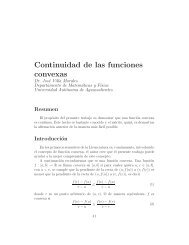Chapter 4 Linear Differential Operators
Chapter 4 Linear Differential Operators
Chapter 4 Linear Differential Operators
You also want an ePaper? Increase the reach of your titles
YUMPU automatically turns print PDFs into web optimized ePapers that Google loves.
132 CHAPTER 4. LINEAR DIFFERENTIAL OPERATORS<br />
where<br />
then the sum does indeed converge to y.<br />
Let<br />
am = 〈ym, y〉, (4.91)<br />
hn = y −<br />
n−1<br />
m=0<br />
amym<br />
(4.92)<br />
be the residual error after the first n terms. By definition, hn ∈ V ⊥ n . Let<br />
us assume that we have adjusted, by adding a constant to q if necessary, L<br />
so that all the λm are positive. This adjustment will not affect the ym. We<br />
expand out<br />
〈hn, Lhn〉 = 〈y, Ly〉 −<br />
n−1<br />
m=0<br />
λm|am| 2 , (4.93)<br />
where we have made use of the orthonormality of the ym. The subtracted<br />
sum is guaranteed positive, so<br />
〈hn, Lhn〉 ≤ 〈y, Ly〉. (4.94)<br />
Combining this inequality with Rayleigh-Ritz tells us that<br />
In other words<br />
〈y, Ly〉<br />
〈hn, hn〉 ≥ 〈hn, Lhn〉<br />
〈hn, hn〉 ≥ λn. (4.95)<br />
〈y, Ly〉<br />
≥ y −<br />
λn<br />
n−1<br />
m=0<br />
amym 2 . (4.96)<br />
Since 〈y, Ly〉 is independent of n, and λn → ∞, we have y − n−1 0 amym2 → 0.<br />
Thus the eigenfunction expansion indeed converges to y, and does so faster<br />
than λ −1<br />
n goes to zero.<br />
Our estimate of the rate of convergence applies only to the expansion of<br />
functions y for which 〈y, Ly〉 is defined — i.e. to functions y ∈ D (L). The<br />
domain D (L) is always a dense subset of the entire Hilbert space L 2 [a, b],<br />
however, and, since a dense subset of a dense subset is also dense in the larger<br />
space, we have shown that the linear span of the eigenfunctions is a dense<br />
subset of L 2 [a, b]. Combining this observation with the alternative definition<br />
of completeness in 2.2.3, we see that the eigenfunctions do indeed form a<br />
complete orthonormal set. Any square integrable function therefore has a<br />
convergent expansion in terms of the ym, but the rate of convergence may<br />
well be slower than that for functions y ∈ D (L).




